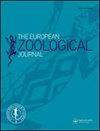不同水分因素对鳙鱼精子运动特性的影响
IF 1.6
4区 生物学
Q2 ZOOLOGY
引用次数: 1
摘要
摘要不同物种的精子具有特定的运动特征和对个体环境因素的敏感性谱。本研究旨在评估精子的运动特性,以及渗透压、钠、钾浓度和pH等水因素对圆精子运动特性的影响。使用计算机辅助精子分析(CASA)和标准化条件测定表征精子运动的运动参数。还测定了其他特征,如精浆的组成以及精子中嘌呤和吡啶核苷酸的浓度。来自天然水道的丘布的精液体积在0.5至3.5mL之间,平均精子浓度为21.5×109mL−1。活动精子的百分比从70%到99%不等。精子在激活后10 s的VCL速度为53.7µms−1,LIN为75.0%,ALH为0.85µm,BCF为15.4 Hz,在15°C和pH为8的蒸馏水中运动持续时间为40 s。外部环境渗透压的增加增加了运动持续时间,速度略有改善。与非离子糖溶液相比,氯化钠和氯化钾溶液中的运动持续时间延长。为了激发最佳的chub精子运动特性,应使用渗透压为150–200 mOsm kg−1、pH为7–8的离子溶液。渗透压接近精浆渗透压280 mOsm kg−1可固定精子。在精浆中,与其他代表性的Cypriniformes相比,在chub中检测到Na+和K+浓度之间的更高分散性。静止精子中ATP的平均浓度为37.9pmol 10−6细胞。尽管在麋鹿身上检测到了一些特性,但胖乎乎的精子运动特性及其对环境的敏感性是典型的Cypriniformes。根据不同分类群对环境成分的敏感性对鱼类进行的研究应该继续下去,因为它们彼此不同。本文章由计算机程序翻译,如有差异,请以英文原文为准。
Spermatozoa motility traits of chub (Squalius cephalus L.) under the influence of various water factors
Abstract Spermatozoa of different species are characterised by specific traits of movement and sensitivity spectrum to individual environmental factors. The present study aimed to evaluate spermatozoa motility traits and the effect of some water factors such as osmolality, sodium, potassium concentration, and pH on chub spermatozoa movement characteristics. Motility parameters characterising spermatozoa motility were determined using computer-assisted sperm analysis (CASA) and standardised conditions. Other features were also determined, such as the composition of seminal plasma and purine and pyridine nucleotide concentration in spermatozoa. The milt volume of chub from a natural watercourse ranged from 0.5 to 3.5 mL, and the mean spermatozoa concentration was 21.5 × 109 mL−1. Percentage of motile spermatozoa varied from 70% to 99%. Spermatozoa achieved VCL velocity of 53.7 µms−1, LIN of 75.0%, ALH of 0.85 µm, BCF of 15.4 Hz at 10 s post-activation and motility duration of 40 s in distilled water at 15°C and pH 8. The increasing osmolality of the external environment increased motility duration and slightly improved velocity. Motility duration was prolonged in sodium and potassium chloride solutions compared to non-ionic sugar solutions. In order to trigger the best chub’s spermatozoa motility trait, an ionic solution of osmolality of 150–200 mOsm kg−1 and pH 7–8 should be used. Osmolality close to the osmolality of seminal plasma 280 mOsm kg−1 immobilises spermatozoa. In seminal plasma, higher dispersion between the Na+ and K+ concentration was detected in chub compared to other representatives of Cypriniformes. The mean ATP concentration in immotile spermatozoa was 37.9 pmol 10−6 cells. Although some peculiarities in milt were detected, the spermatozoa motility traits of chub and its sensitivity to the environment are typical for Cypriniformes. Research in fish from different taxa according to their sensitivity to environmental components should continue as they differ from each other.
求助全文
通过发布文献求助,成功后即可免费获取论文全文。
去求助
来源期刊

European Zoological Journal
Agricultural and Biological Sciences-Animal Science and Zoology
CiteScore
3.10
自引率
5.60%
发文量
80
审稿时长
30 weeks
期刊介绍:
The European Zoological Journal (previously Italian Journal of Zoology) is an open access journal devoted to the study of all aspects of basic, comparative and applied protozoan and animal biology at molecular, cellular, tissue, organ, organismal, population, and community-ecosystem level. Papers covering multiple levels of organization and integrative approaches to study animal form, function, development, ecology, evolution and systematics are welcome. First established in 1930 under the name of Il Bollettino di Zoologia, the journal now has an international focus, reflected through its global editorial board, and wide author and readership.
 求助内容:
求助内容: 应助结果提醒方式:
应助结果提醒方式:


